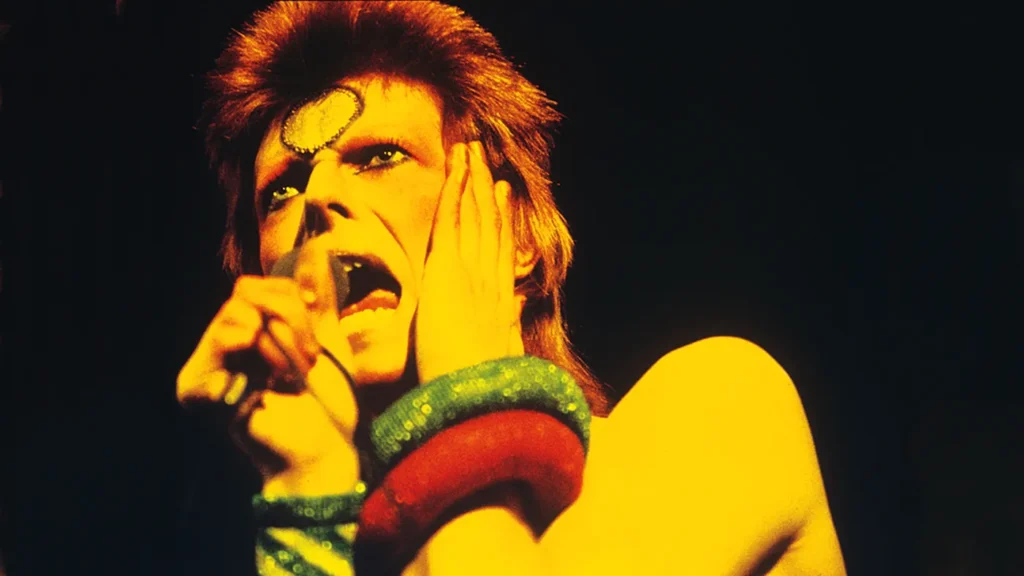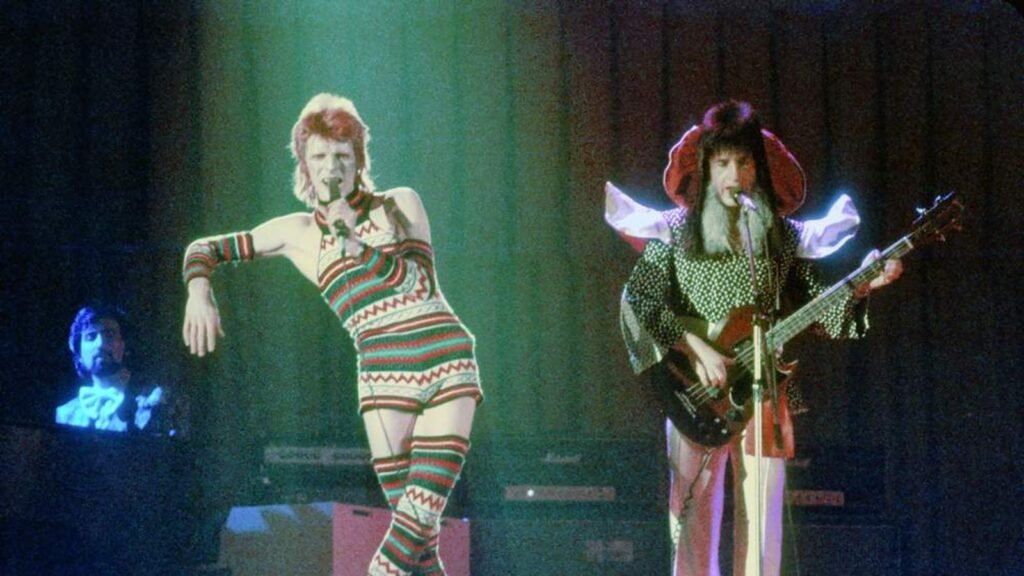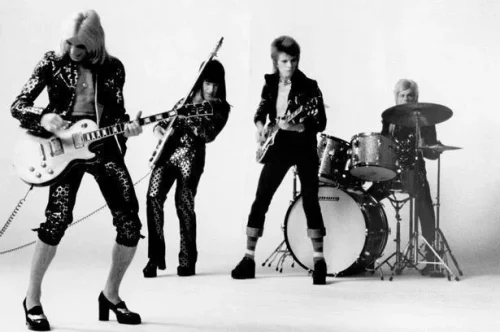David Bowie, a name synonymous with innovation and reinvention, left an indelible mark on the music industry with his eclectic style and artistic vision. Among his many personas, none were as groundbreaking and iconic as Ziggy Stardust, brought to life with the help of his backing band, the Spiders from Mars. Formed in the early 1970s, this group of talented musicians played a pivotal role in transforming Bowie from a promising artist into a global superstar.
The Spiders from Mars were more than just a backing band; they were the driving force behind Bowie’s revolutionary sound during the glam rock era. Their collaboration began with the seminal album The Rise and Fall of Ziggy Stardust and the Spiders from Mars (1972), which catapulted Bowie to new heights of fame. This concept album, with its vivid storytelling and flamboyant characters, captured the imagination of a generation and defined the glam rock movement.
The impact of the Spiders from Mars on rock music was profound. They helped Bowie craft a unique blend of rock, theater, and fashion, pushing the boundaries of what a rock band could be. Mick Ronson’s innovative guitar work, Trevor Bolder’s dynamic bass lines, and Woody Woodmansey’s powerful drumming created a soundscape that was both futuristic and timeless. Their music was characterized by bold melodies, dramatic arrangements, and an androgynous aesthetic that challenged conventional norms.
As Ziggy Stardust, Bowie adopted an otherworldly persona that blurred the lines between performer and character. This alter ego, supported by the Spiders from Mars, allowed Bowie to explore themes of identity, alienation, and fame in ways that resonated deeply with fans. Their theatrical performances and striking visuals set a new standard for live shows, influencing countless artists who followed.
Formation and Early Years

Background on David Bowie’s Transition
In the late 1960s, David Bowie was a versatile artist still searching for his definitive voice. His early works, such as the self-titled debut album David Bowie (1967), displayed a mix of folk, pop, and experimental sounds, reflecting the eclectic musical landscape of the time. Songs like “Space Oddity” hinted at his potential, but Bowie was yet to find a cohesive style that would set him apart from his contemporaries.
The turn of the decade marked a significant shift in Bowie’s musical journey. Influenced by the burgeoning glam rock scene and inspired by artists like Marc Bolan of T. Rex, Bowie began to craft a new persona that fused music with theatrical flair. This period of transformation culminated in the creation of Ziggy Stardust, a flamboyant and androgynous alien rock star, which would become one of Bowie’s most iconic alter egos.
Formation of the Spiders from Mars
The birth of Ziggy Stardust was intrinsically linked to the formation of the Spiders from Mars. In 1970, Bowie enlisted the talents of guitarist Mick Ronson, bassist Trevor Bolder, and drummer Mick “Woody” Woodmansey to form his new backing band. This lineup proved to be the perfect complement to Bowie’s visionary concepts, each member bringing their own unique style and expertise to the group.
Mick Ronson, with his virtuosic guitar skills and melodic sensibilities, quickly became Bowie’s right-hand man. His ability to translate Bowie’s ideas into powerful riffs and memorable solos was crucial to the band’s success. Trevor Bolder’s inventive bass lines provided a solid foundation, while Woody Woodmansey’s energetic drumming infused the music with a driving force that was both raw and polished.
The chemistry between Bowie and the Spiders from Mars was evident from the start. Their collaborative efforts began to take shape in the studio, leading to the creation of groundbreaking tracks that would soon captivate audiences worldwide.
First Performances and Initial Reactions
The Spiders from Mars made their live debut in 1972, coinciding with the release of The Rise and Fall of Ziggy Stardust and the Spiders from Mars. Their early performances were electrifying, marked by Bowie’s dramatic stage presence and the band’s tight, dynamic musicianship. The theatricality of their shows, complete with elaborate costumes and makeup, was unlike anything the rock scene had witnessed before.
Audiences were initially stunned by the audaciousness of Ziggy Stardust and his Spiders. Bowie’s androgynous appearance and provocative antics challenged societal norms, eliciting both admiration and controversy. Critics were quick to recognize the brilliance of the music, praising the band’s innovative sound and Bowie’s charismatic leadership.
As word spread, the Spiders from Mars began to attract a dedicated following. Their performances at venues like London’s Rainbow Theatre and New York’s Carnegie Hall became legendary, drawing enthusiastic crowds and cementing their status as pioneers of glam rock. The combination of Bowie’s visionary artistry and the Spiders’ exceptional musicianship created a powerful synergy that resonated deeply with fans and critics alike.
The Glam Rock Revolution

Defining the Glam Rock Sound
The Spiders from Mars were instrumental in defining the sound and aesthetic of glam rock, a genre characterized by its flamboyant style, theatrical performances, and blending of rock and pop influences. At the heart of this revolution was the synergy between David Bowie’s visionary artistry and the Spiders’ musical prowess. Glam rock emerged as a reaction against the earnestness of the late 1960s rock scene, injecting a sense of spectacle and androgyny that challenged conventional norms.
Mick Ronson’s guitar work was a cornerstone of this new sound. His playing combined raw power with melodic sophistication, creating riffs and solos that were both memorable and innovative. Trevor Bolder’s bass lines added depth and groove, while Woody Woodmansey’s drumming provided a dynamic and propulsive rhythm. Together, they crafted a sound that was both gritty and polished, capable of capturing the otherworldly essence of Bowie’s vision.
The Spiders from Mars’ music was marked by its boldness and originality. They embraced a wide range of influences, from the rock ‘n’ roll of the 1950s to the avant-garde experiments of the 1960s, blending them into a distinctive style that was uniquely their own. Their sound was characterized by powerful guitar riffs, catchy melodies, and elaborate arrangements, all of which became hallmarks of the glam rock genre.
Key Albums and Hits
Two albums stand out as pivotal in the Spiders from Mars’ discography: The Rise and Fall of Ziggy Stardust and the Spiders from Mars (1972) and Aladdin Sane (1973). These records not only defined Bowie’s career but also cemented the band’s place in rock history.
The Rise and Fall of Ziggy Stardust and the Spiders from Mars was a concept album that told the story of Ziggy Stardust, an alien rock star who arrives on Earth to deliver a message of hope in the face of impending apocalypse. The album’s narrative structure, combined with its eclectic mix of rock, pop, and cabaret influences, captured the imagination of a generation. Tracks like “Starman,” with its anthemic chorus and uplifting melody, and “Suffragette City,” with its driving rhythm and rebellious spirit, became instant classics. The album’s success catapulted Bowie and the Spiders from Mars to international stardom.
Aladdin Sane, released the following year, built on the success of Ziggy Stardust while introducing a darker, more introspective tone. Described by Bowie as “Ziggy goes to America,” the album reflected his experiences touring the United States. Songs like “The Jean Genie,” with its bluesy riff and gritty lyrics, and “Drive-In Saturday,” with its nostalgic nod to 1950s pop culture, showcased the band’s versatility and Bowie’s lyrical prowess. The album’s title track, featuring a haunting piano solo by Mike Garson, highlighted the experimental edge that defined much of Bowie’s work.
Bowie’s Alter Ego – Ziggy Stardust
Ziggy Stardust was more than just a character; he was a persona that allowed David Bowie to explore themes of identity, alienation, and fame. Ziggy was an alien rock star sent to Earth with a message of hope, but who ultimately succumbs to the excesses of stardom. This alter ego was a manifestation of Bowie’s fascination with the intersection of art and reality, and his ability to blur the lines between the two.
The Spiders from Mars were integral to bringing Ziggy Stardust to life. Their musicality and stage presence complemented Bowie’s theatricality, creating a complete sensory experience for the audience. Mick Ronson, in particular, played a key role in shaping Ziggy’s sound. His guitar work provided the backbone for many of the album’s most memorable tracks, while his stage presence, often matching Bowie’s in its flamboyance, reinforced the character’s androgynous and otherworldly appeal.
The live performances of Ziggy Stardust and the Spiders from Mars were legendary, marked by elaborate costumes, dramatic lighting, and a sense of spectacle that was revolutionary for its time. Bowie’s embodiment of Ziggy was both captivating and unsettling, challenging audiences to reconsider their perceptions of gender, sexuality, and fame.
Musical and Performance Innovations

Innovative Guitar Work
Mick Ronson’s guitar work was a defining element of the Spiders from Mars’ sound, setting the band apart from their contemporaries. Ronson’s style blended technical proficiency with an innate sense of melody and emotion. His ability to shift seamlessly from powerful riffs to intricate solos provided a dynamic foundation for Bowie’s theatrical storytelling.
Ronson’s use of feedback, sustain, and distortion created a rich, textured sound that was both gritty and polished. His solos were often characterized by their melodic sensibility, as seen in songs like “Moonage Daydream,” where his soaring guitar lines added an ethereal quality to the track. In “Suffragette City,” Ronson’s driving rhythm guitar propelled the song forward with an infectious energy that became a hallmark of the Spiders’ sound.
His influence extended beyond his playing to his arrangements and production skills. Ronson’s contributions were crucial in shaping the sonic landscape of albums like The Rise and Fall of Ziggy Stardust and the Spiders from Mars and Aladdin Sane. His ability to orchestrate complex arrangements while maintaining a rock sensibility helped create a sound that was both innovative and accessible.
Stage Presence and Visuals
The Spiders from Mars were as much about visual spectacle as they were about music. Their stage shows were marked by flamboyant costumes, dramatic lighting, and a theatricality that set new standards for live rock performances. David Bowie’s androgynous persona, particularly in his Ziggy Stardust guise, challenged conventional norms and redefined what a rock star could be.
Bowie’s costumes, often designed by Freddie Burretti and Kansai Yamamoto, were bold, colorful, and futuristic. They included tight jumpsuits, platform boots, and dramatic makeup, which together created an otherworldly appearance. Bowie’s androgynous look, with his bright red hair and elaborate outfits, blurred gender lines and made a powerful statement about identity and self-expression.
The Spiders from Mars complemented Bowie’s flamboyance with their own distinctive styles. Mick Ronson’s glam rock attire and charismatic stage presence, Trevor Bolder’s striking sideburns and flashy outfits, and Woody Woodmansey’s energetic drumming contributed to the band’s cohesive and captivating visual presentation. Their synchronized movements and choreographed performances added to the overall spectacle, making each concert a memorable experience.
Influence on Live Performance
The Spiders from Mars set new standards for live rock performances, blending music, theater, and visual art into a cohesive whole. Their concerts were not just musical events but immersive experiences that engaged all the senses. This approach influenced countless artists and set a precedent for the integration of elaborate stagecraft in rock music.
Their use of lighting and staging was revolutionary for its time. The dramatic use of spotlights, colored gels, and backlighting created a visually stunning environment that enhanced the music’s emotional impact. Bowie’s ability to transform the stage into a space where fantasy and reality intersected was a key part of their appeal.
Moreover, the Spiders from Mars’ willingness to push boundaries and challenge societal norms resonated deeply with fans. Their performances were a celebration of individuality and self-expression, encouraging audiences to embrace their true selves. This message of authenticity and liberation had a lasting impact on the rock genre, inspiring future generations of artists to explore new forms of creative expression.
Closing Thoughts

The legacy of the Spiders from Mars is one that continues to resonate throughout the world of rock music and popular culture. As David Bowie’s backing band during a transformative period of his career, the Spiders from Mars played an integral role in shaping the sound and style of the glam rock movement, leaving an indelible mark on the genre and beyond.
The Spiders from Mars were more than just musicians; they were collaborators and innovators who helped bring Bowie’s visionary concepts to life. Mick Ronson’s masterful guitar work, Trevor Bolder’s inventive bass lines, and Woody Woodmansey’s powerful drumming combined to create a sound that was both groundbreaking and timeless. Their contributions to seminal albums like The Rise and Fall of Ziggy Stardust and the Spiders from Mars and Aladdin Sane helped to redefine the boundaries of rock music, blending rock, pop, and theatrical elements into a cohesive and captivating whole.
